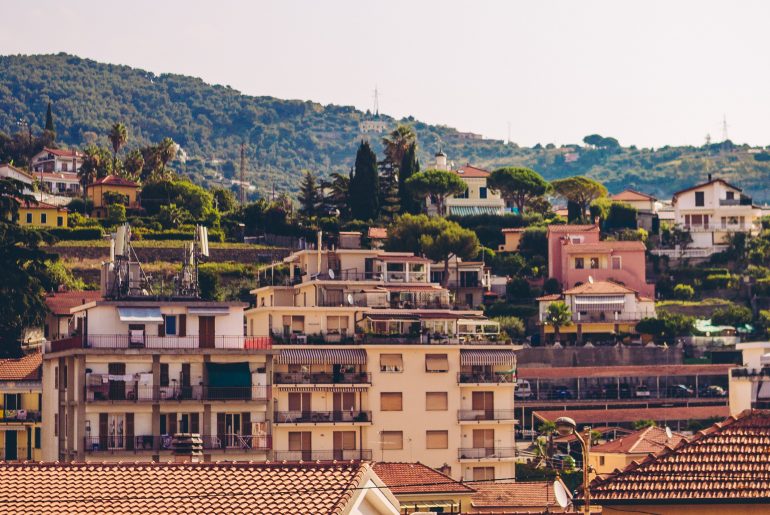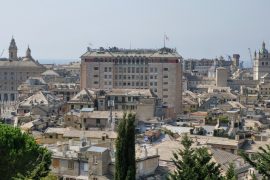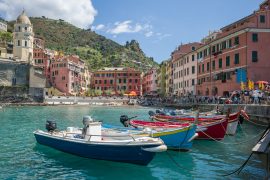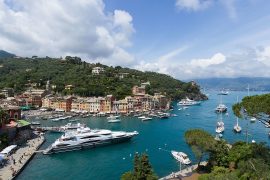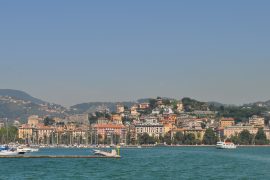Tourists looking for an attractive resort in the northwestern part of Italy should definitely take an interest in San Remo. It is an unusual place on the Italian tourist map, which impresses with its fairy-tale landscape. It is a rare example of a city that is suitable for both lovers of seaside vacations and mountain tourism. What does San Remo offer and when is the best time to go there?
San Remo is a small city of 55,000 inhabitants in the province of Imperia. However, it is a popular vacation destination for many Europeans, who are attracted here primarily by the city's unusual location. It is located just a few dozen kilometers from the majestic peaks of the Ligurian Alps, and last but not least, it is located on the very shores of the Mediterranean Sea.
The city is best known for Italian Song Festival, which has been held here since 1951 - over the years many famous Italian and foreign artists have performed on the festival stage. In addition, the city is known for its prized flower farms and olive oil production. We invite you to read our guide to San Remo!
San Remo and surroundings - what is worth visiting?
Both San Remo and its immediate surroundings have many interesting attractions to offer tourists, both in terms of architecture, culture and nature.
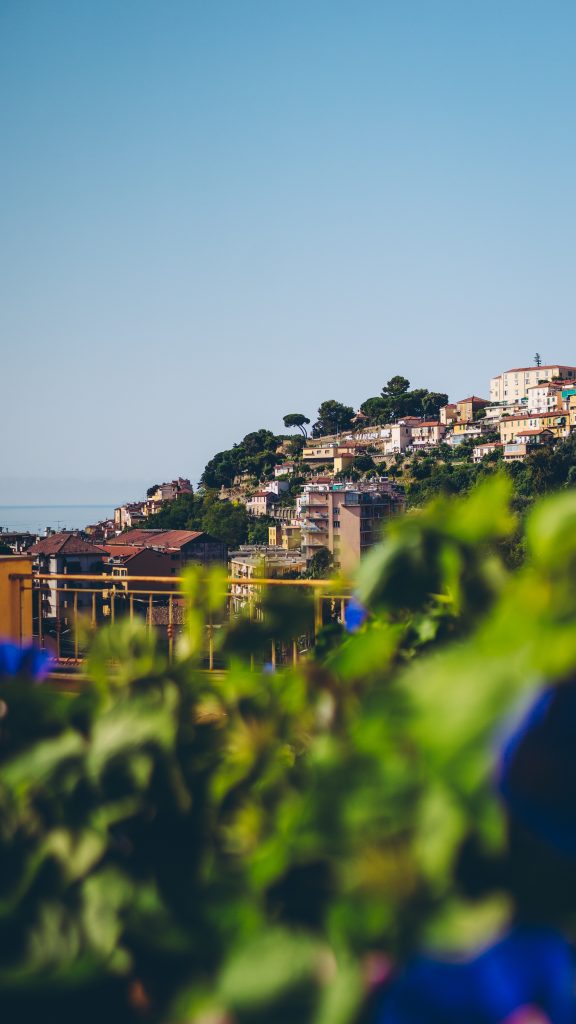
Forte Santa Tecla
Forte Santa Tecla, in terms of size and historical significance, is one of San Remo's most important monuments. It is located in the green part of the city, near the coast. This 18th-century fortress was built by the Genoese as part of the city's defensive bulwark. Until recently, the building functioned as a court prison, and is now a venue for exhibitions and conferences. In addition to the exhibition center, a small museum operates here, collecting exhibits related to the history of the region.
At the moment, the site does not offer regular sightseeing opportunities, but it is worth visiting the area around this fortress, if only on a walk to the nearby port.
Museo Civico
San Remo Museum has exhibits on archaeology related to the region, including a section on the remains of the Roman towns of Bussana and Foce. There is also a collection of paintings by Ligurian painters. The museum is only 450m from Forte Santa Tecla.
The museum is open Tuesday through Saturday from 9 a.m. to 7 p.m. Admission for an adult is €3, a discounted ticket is €2.
Museo del Fiore
Another interesting museum to visit is the Museo del Fiore, which was erected in the Villa Ormond park and aims to present the history of local flower cultivation. The museum consists of two rooms, which host a variety of botany-related events. There is also a greenhouse and a pavilion where temporary exhibitions are held. The tour includes a film on the history of floriculture in San Remo, and there are other multimedia attractions and showcases dedicated to the research institutes involved in the Floriseum. The facility has a rich collection of photos, documents, and tools related to the cultivation of flowering plants in the city.
The museum is open Tuesday through Sunday from 10 a.m. to 12:30 p.m. and 3:30 p.m. to 6 p.m.
Giardini Nobel - the garden of Nobel
Just 180 meters from the Floriseum is the beautiful Giardini Nobel park complex (named after Alfred Nobel, who had his estate nearby), located just off the harbor, specifically the yacht marina. The well-kept park full of exotic flowers and palm trees is a good place for an after-dinner stroll in San Remo. There's also a large fountain with ornate sculptures, plus a plaque dedicated to Polish writer Jozef Ignacy Kraszewski can be seen nearby. Nearby is also the house where the writer lived.
Ariston Theatre
An interesting place on the tourist map of San Remo is the Ariston theater, which has hosted the Italian Song Festival since 1977. There is also a cinema, which shows cinema novelties - the theater itself receives rather average reviews from tourists, if only because of the supposedly not the best acoustics, many visitors do not like the facade of the building, which gives the impression of being taken out of the 60s. But precisely because of these apparent shortcomings, this iconic building is visited by many tourists every year, taking souvenir photos in front of it. It is definitely one of the city's most recognizable locations, and it is certainly worth immersing yourself at least for a moment in this atmosphere of a bygone era - there are simply not many places like this anymore, and they themselves are a kind of monument to history.
The climate of the 1960s is present in San Remo not only due to the Ariston theater building - in many places the city's buildings give the impression of being frozen in time. Slightly neglected facades, adorned by art deco neon signs and the hard-to-describe aura of the neighborhood make up a very distinctive whole, and are in a sense a showcase of the city. San Remo is full of contrasts - there are luxurious hotels and a harbor where the mighty of this world keep their yachts, while at the same time the center and the area around the promenade give the impression of being transported to the present straight from an old postcard.
Casino di Sanremo
The next iconic building is, of course, the Casino di Sanremo, which is now the city's gambling and entertainment center. This Art Nouveau building, specifically its Ballroom, was the original site of the Italian Song Festival. Its turbulent and multifaceted history dates back to the early 20th century, and the first gambling games were held there illegally - although the existence of this practice was a kind of poly-secret, the authorities turned a blind eye. Gambling was legalized only during Mussolini's reign - and then a real golden period began for the casino. Many scandals of the past century are associated with the place, probably because of them, among others, the organization of the festival was moved to the theater building.
Nowadays in the casino you can play traditional games like poker and roulette, in addition, the casino gives you the opportunity to play slot machines and online games. There is also a restaurant and bar on the premises. The premises operate until late at night - from Sunday to Thursday it is open until 2:30 in the morning, and from Friday to Saturday the casino closes at 3:30 a.m. The facility has a dress code - the casino requires visitors' attire to be "neat and appropriate," and a smart casual style is accepted.
Orthodox Church of Christ the Savior
Fans of visiting religious buildings should definitely visit the 1913 Orthodox Church, which was conceived by Tsarina Maria Alexandrovna. The building is inspired by 17th-century Moscow religious architecture, with distinctive towers decorated with colorful mosaics.
The interior of the temple itself is modest, being equipped with 3 altars and a three-row iconostasis. In the 1960s, the building underwent a major renovation, which it required after the 1940 bombing. The renovation restored the Orthodox church to a state of splendor and today it is one of San Remo's major attractions.
Beaches in San Remo
Although San Remo is regarded as a seaside resort, the beaches themselves do not stand out from competing resorts. The natural substrate in the area is rocky or pebbled. The beach is also paved in many places, and much of the local coastline is occupied by yacht marinas and a harbor area.
There are functioning sandy beaches in the western part of the city, but they are man-made and largely owned by local hotels. Public beaches make up a small percentage on this side of San Remo, and due to the large number of tourists, they are virtually full throughout the season.
Many tourists are disappointed with the availability of public beaches in the city and - if they have the opportunity - look for a place to sunbathe outside of San Remo. One of the best beaches of this resort is the one located at Strada Tre Ponti - the sandy ground and flat descent to the water are assets of this place and cause crowds of tourists from all over the area. The place is suitable for families with children. Tre Ponti beach However, definitely can not be recommended to people who do not like crowds and come to San Remo in the summer - the place is besieged even in the low season, which only sums up the plight of beachgoers in the area.
How to get to San Remo? Directions
Poland, unfortunately, does not have an attractive connection to San Remo, nor to nearby towns. The easiest way to get here is by car - the route from Warsaw to San Remo is 1784 kilometers long, and the trip should take about 19 hours.
You can also try to get to San Remo by plane. Admittedly, it won't be a direct trip, because planes from Warsaw don't fly to this city, only to nearby Nice - and only from the end of March. The route is operated by Wizzair - you can get to Nice from the capital and from Cracow (route active since August), and the cost of the ticket is a few hundred zlotys one way.
It is possible to get from Nice to San Remo by public transportation, with one change, and the time of this section of the journey is just over two hours.
Those looking for a budget flight to San Remo may like the option of flying with a low-cost airline to Bergamo, from where you can get to your destination in about 5.5h aboard a bus from the airport and later by train.
As you can see, there are several options, but all forms of transportation (except one's own car) are multi-legged and may bore less patient travelers.
Weather in San Remo
San Remo is a city with a Mediterranean climate, the characteristics of which are mild, fairly rainy winters and sunny, warm summers. The warmest month in San Remo is August, with a maximum temperature of 27 degrees Celsius and a minimum temperature hovering around 20 degrees.
From June to September, the average temperature in San Remo exceeds 20 degrees - the situation is similar with the water temperature. The rainiest months are October, November and December - the total monthly rainfall then is about 100mm, and in November it is even higher. The least rainfall here is in July and August, which is actually not surprising - a similar situation applies to most of the italian resorts.
A good month to visit San Remo is June, when the days are already warm and long, the sea temperature is satisfactory, and tourist traffic has not yet peaked.
What does the kitchen look like in San Remo?
One of the most important traditional dishes of Liguria is the Buridda, which is a soup-fish stew with a rich flavor. Among the ingredients are monkfish, squid, shrimp, clams and fish - these most important elements are added only at the end, the base of the soup is fish broth with tomatoes and other vegetables. This local dish is served with a side of toasted bread with garlic.
The regional flavors of Liguria also include a dish called Sardenaira, which is very similar to pizza, but is served without cheese. Popular additions to this traditional baked good include tomatoes, capers and anchovies.
A characteristic dish of northern Italian cuisine is also the Torta verde, which is cooked rice with vegetables (zucchini predominates) in a thin pastry shell. Added to the stuffing of the dish is onion, egg, and aromatic grana padano cheese. After wrapping the pan-cooked stuffing in the wheat dough, the dish is placed in the oven at 180 degrees and baked for about half an hour.
Accommodation in San Remo
San Remo has a sizable base of accommodations at varying prices. Most of the listings on the popular booking portal belong to private apartments, while the rest are hotels, guest houses and vacation homes. In August, the cheapest accommodation for two people costs about €50 - this is an offer to rent a private apartment located 900m from the beach and 5 km from the center.
For about 65€/day you can already rent a large room in a three-star establishment, which is located 50m from the center and 350m from the beach. On the other hand, for a stay in a four-star hotel close to the beach you have to pay much more, from 145€ upwards per room.
It is worth coming to San Remo in the off-season - then you can count on more free accommodations to choose from and slightly better prices. The city is also less crowded then, which makes for comfortable sightseeing.
Booking.com
